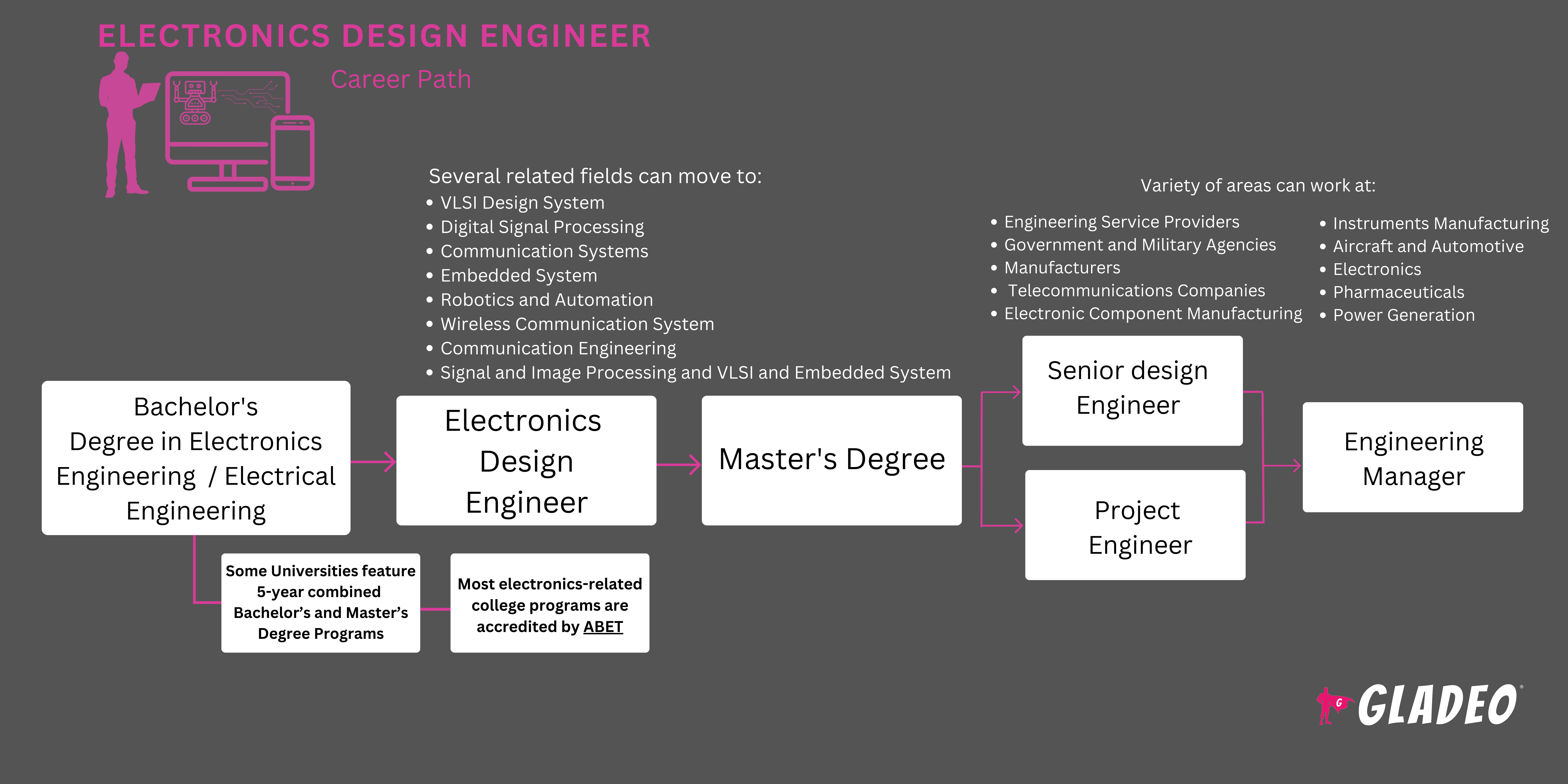Spotlights
Compatibility Test Engineer, Design Engineer, Electronics Design Engineer, Engineer, Evaluation Engineer, Integrated Circuit Design Engineer (IC Design Engineer), Product Engineer, Radio Frequency Engineer (RF Engineer), Research and Development Engineer (R and D Engineer), Test Engineer
The 21st Century is filled to the brim with high-tech gadgets that we’ve come to take for granted. From our portable electronic devices like smartphones, smartwatches, cameras, and tablets to electric stoves, microwaves, printers, electric guitars, and more, we’re totally surrounded by electronics. Meanwhile, many things that aren’t considered “electronics” have electronic components, such as aircraft, boats, drones, and modern cars. Who’s behind the creation of all these complex, sophisticated internal electronic elements? Electronics Design Engineers!
These hard-working engineers specialize in developing electronics for equipment in a variety of industries, including telecommunications, commercial manufacturing, medical, military, aerospace, automotive, and many more. They’re involved in the entire development life cycle, from initial planning processes and estimating costs based on customer needs to schematics design, prototype development, and beyond. Without the efforts of Electronics Design Engineers, modern society as we know it wouldn’t exist!
- Providing electronics solutions for numerous industries
- Pushing technologies forward and helping introduce advanced devices and components
- Contributing to the tech economy at large
Lịch làm việc
- Electronics Design Engineers work full-time, usually in office or lab settings. Overtime may be needed in rush situations. Some travel may be necessary for site visits or to attend meetings.
Nhiệm vụ tiêu biểu
- Meet with clients or employers to review product needs and specific requirements
- Offer realistic cost projections and details about potential product capabilities
- Collaborate with design teams and electrical engineers on projects
- Recommend materials to use or avoid
- Design electronic hardware devices, components, systems, and software
- Develop schematic diagrams and layouts
- Provide suggestions and technical support during the development stages
- Create or manage product prototypes to assess the feasibility
- Ensure circuits meet safety regulations and standards
- Assist with production processes, as needed
- Ensure manufacturing timelines, budgets, and quality are met
- Create and analyze computer models and simulations under various conditions
- Perform reliability testing to ensure proper performance
- Travel to testing sites, as needed
- Help with application development and testing
- Conduct thorough safety compliance inspections of systems, instruments, and equipment
- Coordinate the installation and testing of parts, equipment, or programs
- Repair or oversee repairs of inoperable damaged equipment
- Establish and enforce routine maintenance protocols
- Review consumer complaints and offer solutions
- Conduct diligent research and stay up to date on technological advances
- Write and edit technical documentation
Trách nhiệm bổ sung
- Train and mentor project team members
- Work to streamline processes and improve efficiency
- Suggest modifications and improvements to existing parts or systems
- Aid with patent applications, as needed
Kỹ năng mềm
- Chú ý đến chi tiết
- Định hướng tuân thủ
- Tư duy phản biện
- Độc lập
- Sáng kiến
- Tầm nhìn màu bình thường
- Tổ chức
- Giải quyết vấn đề
- Đảm bảo chất lượng
- Đáng tin cậy
- Tháo vát
- Định hướng kết quả
- Ý thức an toàn
- Kỹ năng giao tiếp mạnh mẽ
- Làm việc theo nhóm
- Quản lý thời gian
- Troubleshooting
Kỹ năng kỹ thuật
- Circuit board assembly testing
- Knowledge of electronics circuits, power supplies, design, and engineering
- Electrical hand tools and testing equipment such as oscilloscopes
- EMI noise reduction
- Failure mode and effects analysis
- Gate driver design
- High volume analog and digital embedded instrument design
- Insultated-gate field effect transistors
- Knowledge of OSHA electrical safety standards and UL certification
- PCB layout design
- Programming languages like C/C++, Verilog, VHDL, Python, and MATLAB
- Simulation and computer-aided design software
- Technical research and writing ability
- Training in electrical design systems engineering
- Understanding of circuit design and applicable software such as Altium Designer, OrCAD, Siemens PADS, or Autodesk EAGLE
- Engineering service providers
- Các cơ quan chính phủ và quân đội
- Nhà sản xuất
- Các công ty viễn thông
Technology advances at such a rapid pace, in part, because there’s so much competition. As soon as a manufacturer produces a high-tech product, the next day it and all of its competing companies are working to build something even better. Electronics Design Engineers have to work on the cutting edge, pushing boundaries and redefining what is possible.
As they do so, they know that around the world others are doing exactly the same thing, trying to beat them to the punch! This phenomenon is observable in virtually every industry, but especially in consumer retail products and within the military-industrial complex. Indeed, most countries invest heavily in their national defense, which includes never-ending R&D for technologies to be used by militaries. Thus, Electronics Design Engineers should be aware of the potential uses and ramifications of their work, while trying to stay ahead of the curve through continuous learning.
The fast-paced world of electronics design is always on the lookout for new advances that will improve efficiency and production. One of the biggest trends in this space is the rise of virtual reality, not only in games and entertainment but also for medical and military training purposes. In addition, there’s a significant increase in the development of smart devices. These are nothing new, but they are rapidly replacing our “dumber” gadgets as they interconnect with the Internet of Things.
Meanwhile, the spread of 5G networks is boosting device capabilities, in turn driving the need for faster devices. In manufacturing, AI and robotics are becoming even more prevalent, replacing human workers in some areas so that production is streamlined and more sophisticated. To some extent, this is narrowing and redefining the job outlook for engineers. These are just a few of the top trends impacting the industry!
Electronics Design Engineers may have enjoyed working with mechanical equipment, electrical gadgets, or computers growing up. They are very hands-on and able to focus on technical work for long periods and may have had hands-on hobbies that took up a lot of their time as kids. They tend to be reliable, practical, and innovative problem-solvers!
- Electronics Designers need at least a bachelor’s degree in electrical or electronics engineering
- Some universities feature 5-year combined bachelor’s and master’s degree programs. A master’s isn’t necessary to get started, but it can boost your credentials
- Note, engineering programs should ideally be accredited by ABET
- Các lớp phổ biến có thể bao gồm:
- AC and DC circuits and design
- Differential equations
- Digital systems design
- Electrical circuit theory
- Programming essentials
- Random signal analysis
- Students can often select a minor or area of concentration such as nanotechnology, power systems, mechatronic systems, or renewable energy
- Practical hands-on experience is crucial and can be gained through internships, cooperative programs, or part-time jobs
- Engineers can advance by earning a Professional Engineering (PE) license, which requires passing two exams
- The first PE exam is the Fundamentals of Engineering exam (after which one can apply for an Engineer in Training or intern certification
- Once enough work experience has been gained, workers can take the second PE exam, Principles and Practice of Engineering
- Check if the engineering program is accredited by ABET or not
- Look at the department’s faculty bios, learn about its facilities and current research projects, see what kind of funding they have, read about awards or accomplished alumni, and search the web for honest reviews from graduates
- Find out about post-graduation job placement stats and any program-employer partnerships that might exist
- Quyết định xem bạn sẽ tham gia chương trình học truyền thống tại trường, trực tuyến hay kết hợp (cả hai)
- Consider and compare the costs of tuition and scholarship opportunities
- Apply for federal student aid to see what kind of financial assistance offers you might get from the government and from the school itself
- In high school, future Electronics Design Engineers should sign up for STEM (science, technology, engineering, and math) classes. Physics, algebra, trigonometry, calculus, and drafting are very useful for laying the foundation you’ll need in college
- Volunteer for shop activities where you can get practice working with hand tools, learn about mechanical or electrical systems, and get familiar with general safety practices
- Apply for jobs or internships where you can gain real-world experience
- Consider doing a bit of preparatory self-study via online courses from Udemy or other sites
- Read electronics journals, magazines, and blogs
- Reach out to working Electronics Design Engineers to learn about their jobs. Ask if you can shadow them for a day or even just a few hours
- Become familiar with electrical safety protocols, OSHA standards, and personal protective gear such as eyewear, insulated gloves, or dust masks
- Giữ lại một bản sơ yếu lý lịch mà bạn có thể thêm vào khi bạn có thêm kinh nghiệm

- Scan popular job portals like Indeed.com. Upload your resume and set up notification alerts so you can hear about new postings right away
- Advertise yourself on LinkedIn as open for work
- Consider relocating to a city that has a lot of jobs for Electronics Design Engineers
- For example, the states with the highest employment of electronics engineers are California, Texas, Colorado, Florida, and Arizona
- The highest concentration of jobs is in Colorado, Rhode Island, Maryland, Arizona, and California
- Make sure your resume is error-free and clearly explains your qualifications in a compelling manner
- Review Electronics Design Engineer resume templates for ideas
- If you don’t have a ton of work experience, focus on skills, academic achievements, and any certifications or other credentials
- Study Electronics Design Engineer sample interview questions. Know your terminology, have some real-world examples or stories ready to share, and be able to speak about the state of the industry and where it is heading
- Be familiar with the companies you interview with. Study their websites, look at their range of products and services, and learn about their target customers
- Stay positive and enthusiastic during interviews. Try to do a few mock interviews to practice so you won’t be nervous!
- Your first engineering job will be crucial to how the rest of your career plays out. Focus on doing the best job you can and learning as much as possible
- Be a creative, proactive problem-solver who can work with little direction
- Let your supervisor know you’re willing to do what it takes to advance so you can become an even stronger asset for the company. Demonstrate competence and loyalty
- Always be accountable for your mistakes and demonstrate high degrees of professionalism
- Collaborate well with others, treat coworkers with respect, and train new staff thoroughly
- Make safety a priority! Wear appropriate protective gear and comply with safety protocols when needed
- Build strong relationships with fellow engineers, department heads, and stakeholders
- Get your Professional Engineering license when possible, and consider doing additional certifications or even a master’s or doctorate program
- Keep learning new things about the industry. Read technical manuals and study industry trends
- Get published in industry journals and establish your reputation as a subject matter expert
Các trang web
- Hội đồng công nhận kỹ thuật và công nghệ
- Tất cả về mạch
- Hiệp hội Giáo dục Kỹ thuật Hoa Kỳ
- Apprenticeship.gov
- Association of Old Crows
- EDN Network
- EE Times
- Liên minh đào tạo điện
- Electronic Design
- Thiết bị điện tử dành cho bạn
- Electronics Hub
- Điện tử hàng tuần
- Mũ bảo hiểm đến Hardhats
- IEEE
- Nhà thầu cơ điện độc lập
- Tình anh em quốc tế của công nhân điện
- Hiệp hội Tự động hóa Quốc tế
- Mouser Electronics Bench Talk
- Hội đồng Giám khảo Quốc gia về Kỹ thuật và Khảo sát
- Hiệp hội nhà thầu cơ điện quốc gia
- Hiệp hội kỹ sư chuyên nghiệp quốc gia
- NCCER ·
- Open Electronics
- SparkFun Electronics
- Hiệp hội sinh viên công nghệ
Sách vở
- Electronic Circuit Design and Application, by Stephan Gift and Brent Maundy
- Open Circuits: The Inner Beauty of Electronic Components, by Windell Oskay and Eric Schlaepfer
- Practical Electronic Design for Experimenters, by Louis Frenzel
Electronics Design Engineering is a dynamic, ever-evolving field, but it’s also just one of the many possible career pathways for students interested in electronics or engineering topics. Below are a few similar occupations you might want to research, as well!
- Kỹ sư hàng không vũ trụ
- Bioengineers Engineer
- Kỹ sư phần cứng máy tính
- Electrical and Electronic Engineering Technician
- Electrical and Electronics Repairer
- Electrical Engineers
- Electrical Power-Line Installer
- Thợ điện
- Kỹ thuật viên HVAC
- Lighting Technician
- Mechatronics Engineer
- Microsystems Engineer
- Kỹ sư bán hàng
Nguồn cấp tin tức

Công việc nổi bật

Các khóa học và công cụ trực tuyến

Kỳ vọng về mức lương hàng năm
New workers start around $152K. Median pay is $181K per year. Highly experienced workers can earn around $213K.
Kỳ vọng về mức lương hàng năm
New workers start around $131K. Median pay is $181K per year. Highly experienced workers can earn around $181K.
Kỳ vọng về mức lương hàng năm
New workers start around $80K. Median pay is $107K per year. Highly experienced workers can earn around $171K.







